Horse blanket: functions and varieties
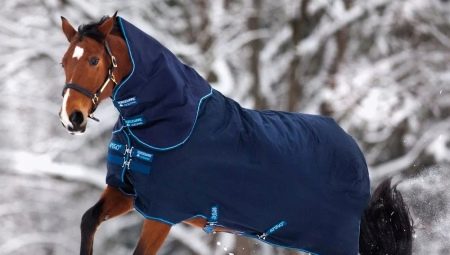
The blanket is an important part of a horse's equipment and is present in the arsenal of most experienced owners. It protects animals from aggressive environmental influences and allows them to always be in the ranks.
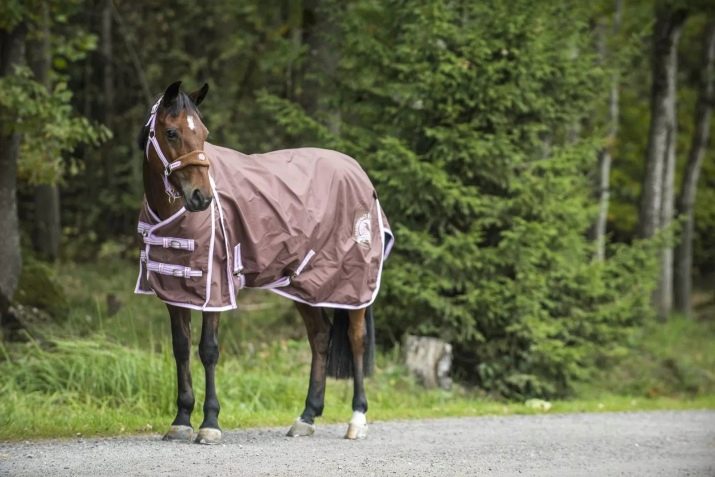
What it is?
The blanket is a horse clothing made in the form of a cape on the body of an animal. The product does not constrain movement at all and leaves the horse's legs free. Domestic horses are especially in need of additional protection, which, unlike their wild counterparts, are regularly washed and brushed. Because of this, there is a gradual decrease in the sebum layer, as a result of which horses become more vulnerable to weather events: they quickly become supercooled in the cold and often begin to get sick.
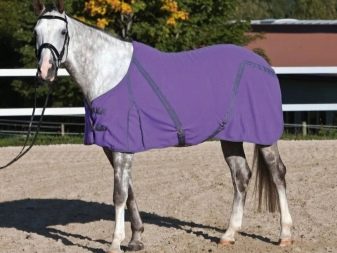
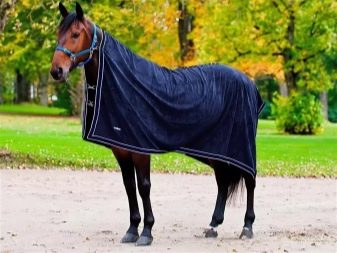
Besides the practical function, the blanket can be used as a decorative accessory and serve solely for beauty. Such models can be seen on circus horses, as well as in parks and squares where animals are used as attractions for children to ride. Another important function of the blanket is to protect the body of the horse from the pressure of the saddle and prevent abrasion of the skin underneath.
The material for making capes is wool, fleece, cotton fabrics and composite fabrics, and the choice of a particular one is dictated by the conditions of keeping the animal, its breed and the purpose of use.
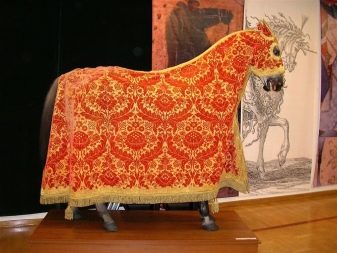
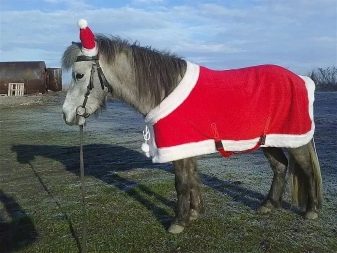

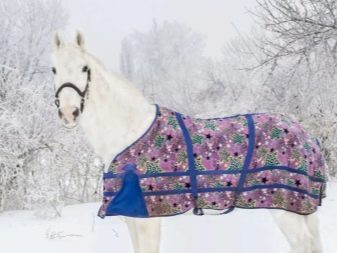
In its cut, the blanket resembles an ordinary bedspread and, depending on the model, is additionally equipped with belts, ties and buckles.
Experienced breeders recommend that owners purchase several different models at once, which will help to raise the animal in all weather conditions and always dress it for the season.In addition, the use of a cape during the autumn period does not allow the animal to hypothermia and "grow" thick winter wool, and this, in turn, greatly facilitates care.
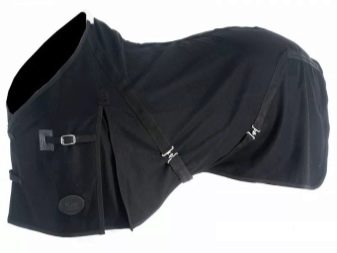
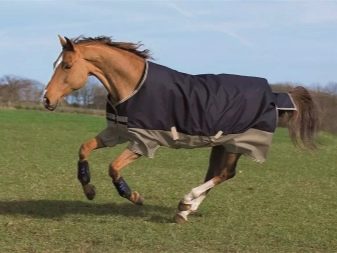
Varieties
The classification of blankets is made according to several criteria, the main of which is the seasonality of clothing. According to this criterion, there are three types of capes: winter, summer and off-season.
Winter
In the cold season, animals kept in harsh climatic zones must necessarily have warm clothing. She should keep the horses warm in the stable and protect them from the cold wind when walking, working or training. The blankets that cover the horse indoors are called stall blankets. They, in turn, are divided into sleeping rooms and drying rooms.
- Drying stall blanket designed to normalize the body temperature of the animal after walking, exercising or working in the fresh air. To sew it, use a waffle cotton fabric or the finest wool. The cloak is put on the horse immediately upon arrival at the stable and remains on it until the body is completely dry. The size of the drying blanket should be large and not restrict the horse's range of motion. The fastening of the cape to the body of the animal is carried out by means of belts located on the inside of it.
- After the horse dries up, the woolen drying cape is removed and thrown over the pet sleeping blanket. Fleece or jute clothing acts as a blanket and protects the horse from hypothermia in a poorly heated stable. The length of the sleeping blanket is slightly shorter than that of the drying blanket, which allows the horse not to get tangled in the fabric when laying down to sleep. To fix the product on the body, external straps are used, which are fastened in front, under the tail and under the belly of the pet.
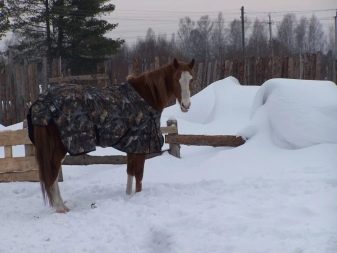
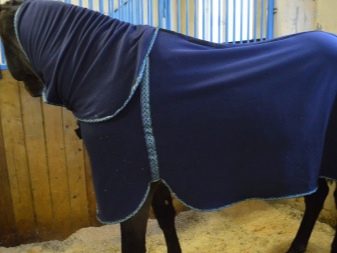
To find a pet on the street, left-handed blankets are used. Such clothes are usually very light, but at the same time very warm, so woolen fabrics are often used for their sewing. It is allowed to use synthetic waterproof and windproof fabrics, but they must be "breathable" and not interfere with normal air exchange. Otherwise, there will be a greenhouse effect: the animal will begin to sweat a lot and may catch a cold.
In terms of cutting, the left-handed models are quite similar to the stall ones and differ from them only by the free edge hanging in front, which is necessary for the convenience of the horse's movement.
Attaching the cape to the body of the animal is also carried out with the help of belts, and some models are additionally equipped with a hood that protects the horse's head and neck from bad weather. In harsh climatic conditions, blankets with an additional layer of padding polyester or other insulation are used.
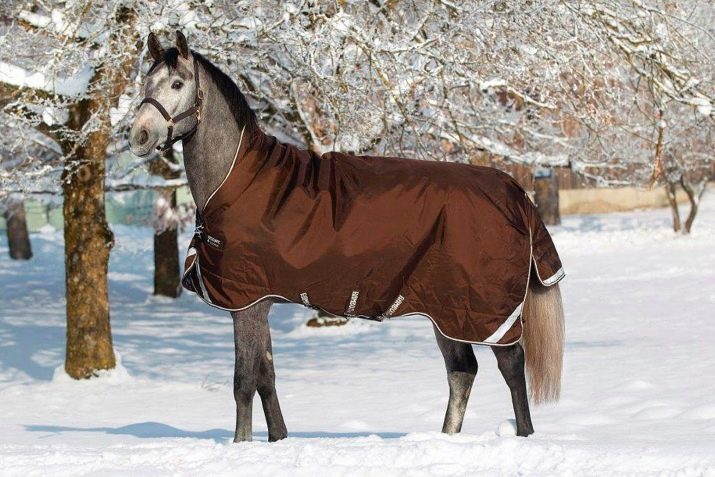
Summer
models also come in several varieties and are divided into three categories.
- Light capes are designed to protect horses from sand, dirt and dust. Washing a thin cape is much easier than washing and brushing a pet. In addition, such clothing helps to level the difference between the temperature in the stable and on the street and prevent hypothermia of the animal when it is pasture in the cold morning hours.
- Mosquito blanket designed to protect your pet from blood-sucking insects, midges and flies. For the manufacture of such models, breathable fabric is used, which provides full air exchange and does not allow the horse to sweat. Often, a mesh fabric acts as such a material, which does not give insects the opportunity to bite an animal or lay eggs, but at the same time does not interfere with ventilation and does not cause overheating.
- Paddock models are elegant blankets and are worn at celebrations and equestrian competitions. Light flowing fabrics such as silk and nylon are used to sew festive capes, while fine wool or cotton is often used for sports and training.Such products, along with their decorative function, protect the horse from pollution and hypothermia.
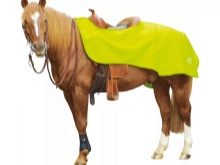
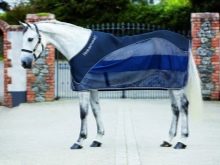

Off-season (or rain) blanket
must also be present in the horse's wardrobe. It reliably protects the pet's body from rain and temperature changes typical for the autumn and spring seasons. Such models are usually two-layer, where the lower one is made of cotton fabric or fine wool, and the upper one is made of water-repellent fabric, which is used as a regular tarpaulin or synthetic canvas.
Besides seasonal patterns, there are saddle blankets used to protect the skin of an animal during long horse rides or training. An important condition for the use of such capes is to carefully smooth out the folds under the saddle and prevent the fabric from slipping and knocking down. Otherwise, the horse's body can be damaged even more than when using a saddle without a protective pad.
There are several more categories of blankets: training, transport and cooling. However, they all relate to special ammunition and are not required to be purchased when keeping a horse in normal household conditions.
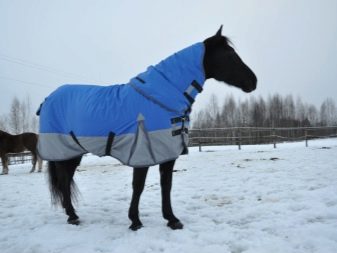
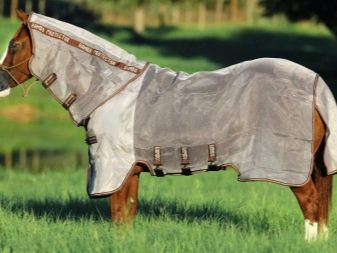
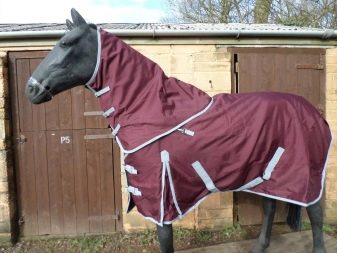
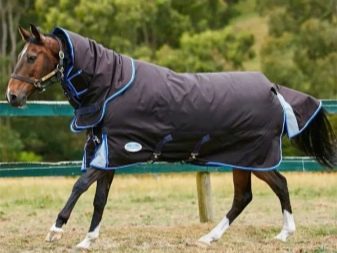
Criterias of choice
Before proceeding with the selection of blankets for a horse, it is necessary to decide for what purposes the model is being purchased, and also take into account the individual characteristics of each specific animal. So, if the pet sweats a lot, then, in addition to the basic kit, it is advisable to purchase a cooling cape for him. If the horse is planned to be transported frequently, then in this case one cannot do without a transport blanket. The product is made of thick soft material and in some cases has soft side inserts. This helps to cushion shocks during transportation and prevents injury to the animal.
When choosing clothes for a horse, you should pay attention to the quality of tailoring of the product. Otherwise, from active contact with sweat and dirt, as well as from frequent washings, the cape will quickly creep and become unusable. That's why first of all, you need to decide on the composition of the fabric and, ideally, purchase natural ones.
However, modern synthetic materials are also of excellent quality and are often not inferior to natural ones in their performance properties. The main thing is that the fabric from which the cape is sewn should allow air to pass through well and be durable.
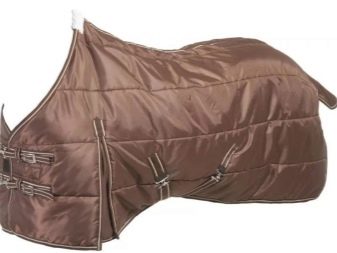
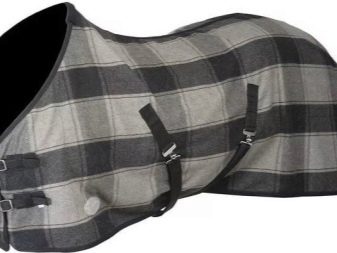
You should also pay attention to the clasps and carabiners of the model. They should be lightweight, open / close well and freely and not jam. Then you need to inspect the lines: they must be absolutely even and double, the presence of protruding threads and raw edges is unacceptable. To determine the size of the model, it is advisable to try it on a horse, since factory products are sewn according to standard patterns and cannot take into account the structural features of the body of each animal.
You should not buy clothes made of rustling materials, as the horse will be frightened when moving.
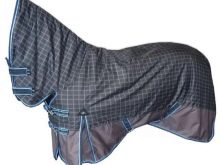
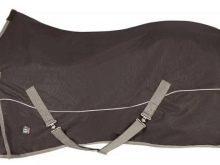
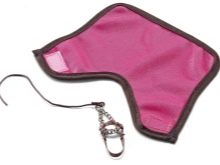
Care rules
In order for horse clothing to last as long as possible and always remain clean and tidy, it is necessary to follow a number of simple recommendations.
- Any cloak needs regular shaking out, airing and drying.
- Blankets should be washed with hypoallergenic powders that do not have a tart chemical odor.
- It is recommended to clean jute models with a stiff brush.
- It is necessary to constantly monitor the condition of the edges of the blanket and, if necessary, to immediately repair them.
- When washing in a washing machine, the water temperature should not exceed 40 degrees.
- It is better to carry out manual cleaning of the cape on special devices (goats) or on a fence. First, you need to hang the cape on the support and remove the main dirt with a coarse brush. Then, in warm water, you need to dilute the laundry soap or washing powder and clean the product with a hard sponge.Then the blanket needs to be rinsed well with a hose and dried in partial shade in a natural way.
It is recommended to store blankets in dry tight bags in a cool and well-ventilated area. This will help to avoid damage by moths and rodents and prevent caking and dampness of products.
See below for information on the need for horse blankets.








